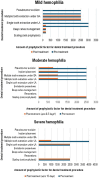Dental management of people with congenital hemophilia: An integrative review of case reports and case series from a global scenario
- PMID: 39707923
- PMCID: PMC11662769
- DOI: 10.1111/scd.13099
Dental management of people with congenital hemophilia: An integrative review of case reports and case series from a global scenario
Abstract
Objective: To analyze the various dental management strategies adopted to manage patients with hemophilia in a dental clinical setup.
Methods: An electronic database search was carried out using MEDLINE by PubMed, Scopus, Google Scholar, Web of Science, and EMBASE databases from January 2000 to August 2023 for case reports and case series published in English language. Case reports addressing the dental treatments for people with hemophilia A/hemophilia B were included. Cases of acquired hemophilia and cases of hemophilia who are inhibitor positive were excluded.
Results: There was a total of 286 articles that were identified of which 24 reports were included for the review. This included 20 case reports and four case series which addressed various dental treatment procedures performed on people with mild/moderate/severe hemophilia A or hemophilia B. A total of 28 patients were presented with a mean age of 20.4 years. The pre-treatment factor ranged from 200 to 2500 IU and the post-treatment factor range was 1000-3000 IU.
Conclusions: There was a wide range of variation in the utilization of prophylactic factors for dental treatment procedures among people with hemophilia. This variation highlights the need for larger prospective clinical studies that address the rationale for using clotting factor concentrate and its impact on dental treatment outcomes for individuals with mild, moderate, or severe hemophilia.
Keywords: comprehensive dental care; hemophilia A; hemophilia B; oral health.
© 2024 The Author(s). Special Care in Dentistry published by Special Care Dentistry Association and Wiley Periodicals LLC.
Conflict of interest statement
All authors hereby declare that there is no conflict of interest.
Figures
Similar articles
-
Hemophilia and oral health.Stomatologija. 2014;16(4):127-31. Stomatologija. 2014. PMID: 25896036 Review.
-
Pulpotomy management using laser diode in pediatric patient with severe hemophilia A under general anesthesia-A case report.Spec Care Dentist. 2018 May;38(3):155-159. doi: 10.1111/scd.12279. Epub 2018 Mar 14. Spec Care Dentist. 2018. PMID: 29537665
-
Antifibrinolytic therapy for preventing oral bleeding in patients with haemophilia or Von Willebrand disease undergoing minor oral surgery or dental extractions.Cochrane Database Syst Rev. 2019 Apr 19;4(4):CD011385. doi: 10.1002/14651858.CD011385.pub3. Cochrane Database Syst Rev. 2019. PMID: 31002742 Free PMC article.
-
Hemophilia and von Willebrand's disease: 2. Management. Association of Hemophilia Clinic Directors of Canada.CMAJ. 1995 Jul 15;153(2):147-57. CMAJ. 1995. PMID: 7600466 Free PMC article.
-
Costs and utilization of treatment in patients with hemophilia.BMC Health Serv Res. 2015 Oct 26;15:484. doi: 10.1186/s12913-015-1134-3. BMC Health Serv Res. 2015. PMID: 26502954 Free PMC article.
Cited by
-
Outcomes of Dental Treatment Procedures in People With Haemophilia Treated Under a Comprehensive Care Model: An Analysis of Cases From a Tertiary Care Centre.Haemophilia. 2025 Jul;31(4):617-624. doi: 10.1111/hae.70055. Epub 2025 May 5. Haemophilia. 2025. PMID: 40322997 Free PMC article.
References
-
- Srivastava A, Santagostino E, Dougall A, et al. WFH guidelines for the management of hemophilia, 3rd edition. Haemophilia. 2020;26:1‐158. - PubMed
-
- Kumar M, Pai KM, Kurien A, Vineetha R. Oral hygiene and dentition status in children and adults with hemophilia: a case–control study. Spec Care Dent. 2018;38:391‐394. - PubMed
-
- Zaliuniene R, Aleksejuniene J, Peciuliene V, Brukiene V. Dental health and disease in patients with haemophilia—a case‐control study. Haemophilia. 2014;20:194‐198. - PubMed
-
- Freedman M, Dougall A, White B. An audit of a protocol for the management of patients with hereditary bleeding disorders undergoing dental treatment. J Disabil Oral Heal. 2009;10:151‐155.
Publication types
MeSH terms
LinkOut - more resources
Full Text Sources
Medical



